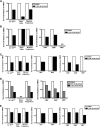Assessment of Drug Sensitivity in Hematopoietic Stem and Progenitor Cells from Acute Myelogenous Leukemia and Myelodysplastic Syndrome Ex Vivo
- PMID: 28297583
- PMCID: PMC5442784
- DOI: 10.5966/sctm.2016-0034
Assessment of Drug Sensitivity in Hematopoietic Stem and Progenitor Cells from Acute Myelogenous Leukemia and Myelodysplastic Syndrome Ex Vivo
Abstract
Current understanding suggests that malignant stem and progenitor cells must be reduced or eliminated for prolonged remissions in myeloid neoplasms such as acute myelogenous leukemia (AML) or myelodysplastic syndrome (MDS). Multicolor flow cytometry has been widely used to distinguish stem and myeloid progenitor cells from other populations in normal and malignant bone marrow. In this study, we present a method for assessing drug sensitivity in MDS and AML patient hematopoietic stem and myeloid progenitor cell populations ex vivo using the investigational Nedd8-activating enzyme inhibitor MLN4924 and standard-of-care agent cytarabine as examples. Utilizing a multicolor flow cytometry antibody panel for identification of hematopoietic stem cells, multipotent progenitors, common myeloid progenitors, granulocyte-monocyte progenitors, and megakaryocyte-erythroid progenitors present in mononuclear cell fractions isolated from bone marrow aspirates, we compare stem and progenitor cell counts after treatment for 24 hours with drug versus diluent. We demonstrate that MLN4924 exerts a cytotoxic effect on MDS and AML stem and progenitor cell populations, whereas cytarabine has more limited effects. Further application of this method for evaluating drug effects on these populations ex vivo and in vivo may inform rational design and selection of therapies in the clinical setting. Stem Cells Translational Medicine 2017;6:840-850.
Keywords: Acute myelogenous leukemia; Hematopoietic stem cells; MLN4924; Myelodysplastic syndrome; Myeloid progenitor cells.
© 2016 The Authors Stem Cells Translational Medicine published by Wiley Periodicals, Inc. on behalf of AlphaMed Press.
Figures




References
-
- Woll PS, Kjällquist U, Chowdhury O et al. Myelodysplastic syndromes are propagated by rare and distinct human cancer stem cells in vivo. Cancer Cell 2014;25:794–808. - PubMed
-
- Lapidot T, Sirard C, Vormoor J et al. A cell initiating human acute myeloid leukaemia after transplantation into SCID mice. Nature 1994;367:645–648. - PubMed
-
- Kreso A, Dick JE. Evolution of the cancer stem cell model. Cell Stem Cell 2014;14:275–291. - PubMed
Publication types
MeSH terms
Substances
Grants and funding
LinkOut - more resources
Full Text Sources
Other Literature Sources
Medical
Research Materials
Miscellaneous

